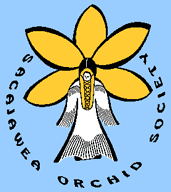|
|
ORCHID SHOW: |
|
|
|
|
When: |
Ribbon Judging will be held on Saturday, from 8:00 a.m. to 10:00 a.m. |
|
Judges: |
The official AOS judges shall be the main
judges of the show, and lead one judging group each during the ribbon judging.
For the AOS judging, they will confer among themselves. |
|
Judging Groups: |
For the ribbon judging, each judging
group shall include one main judge and at least two helpers: one person to
find the plants on the show table, and one person serving as scribe, i.e.
filling out the information on every ribbon awarded. |
|
Ribbons: |
Every Registration Category will be
awarded at least three ribbons: |
|
Rosettes: |
Every |
|
Plaques: |
There will be two Plaques awarded, one
for the best plant of the show, to be chosen among all the rosetted plants,
and one for the best grown plant of the show, to be chosen among all entries. |
|
Public's Choice: |
There will be one Rosette awarded for the
plant among the rosetted plants that gets most of the public's votes. |
|
|
|
|
Ribbon Judging Guidelines: |
Each judging group shall pick the
category they know most about. |
|
1. Flower Count: |
more flowers is better than less flowers |
|
2. Flower Size: |
bigger is better |
|
3. Flower
Presentation |
are the flowers too crowded, too far apart, upside down? |
|
4. Flower Shape/Color: |
are the flowers symetrical, are the colors brilliant and clearly defined? |
|
5. Flower Substance: |
heavy substance is better |
|
|
|
|
|
|
|
Difficulties: |
If it's hard to find the better plants,
you can eliminate based on flaws, for example color bleeding, marring, poor
form, etc. |
|
|
|
